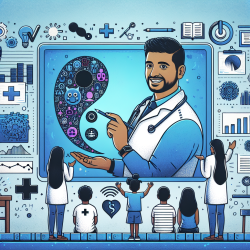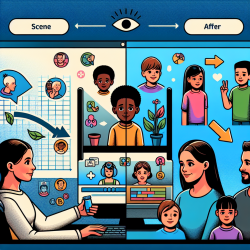Introduction
In the realm of speech language pathology, data-driven decisions are paramount. The study titled "Impact of Service User Video Presentations on Explicit and Implicit Stigma toward Mental Illness among Medical Students in Nepal: A Randomized Controlled Trial" provides a compelling case for the use of video presentations in reducing stigma. This blog explores how practitioners can leverage these findings to enhance their skills and improve outcomes for children.
The Power of Video Presentations
The study conducted in Nepal evaluated the impact of didactic and service user testimonial videos on reducing stigma towards mental illness among medical students. It revealed that both video types effectively reduced stigma when addressing depression alone. However, when both depression and psychosis were included, the effectiveness diminished. This insight is crucial for speech language pathologists aiming to create supportive environments for children with diverse needs.
Implementing Video-Based Strategies
For practitioners, incorporating video-based strategies can be transformative. Here’s how:
- Targeted Content: Focus on specific conditions to maximize impact. Tailor videos to address particular challenges faced by children in speech language therapy.
- Engagement through Testimonials: Use testimonials from individuals who have overcome speech and language difficulties. This humanizes the experience and fosters empathy among peers and educators.
- Interactive Sessions: Combine videos with interactive discussions. This encourages reflection and deepens understanding, promoting a more inclusive environment.
Encouraging Further Research
The study underscores the need for further research, particularly in low- and middle-income countries. Practitioners are encouraged to explore the following areas:
- Longitudinal Studies: Investigate the long-term effects of video presentations on stigma reduction and child outcomes in speech language pathology.
- Cultural Adaptations: Adapt video content to reflect cultural nuances, ensuring relevance and effectiveness in diverse settings.
- Comparative Analysis: Compare the efficacy of video presentations with other intervention methods to identify the most effective strategies.
Conclusion
Video presentations hold immense potential in transforming attitudes towards mental health and improving outcomes for children in speech language pathology. By implementing targeted, engaging, and culturally sensitive video strategies, practitioners can foster more inclusive and supportive environments. As we continue to harness the power of data-driven decisions, let us remain committed to exploring innovative approaches that enhance the lives of children and their families.
To read the original research paper, please follow this link: Impact of Service User Video Presentations on Explicit and Implicit Stigma toward Mental Illness among Medical Students in Nepal: A Randomized Controlled Trial.










